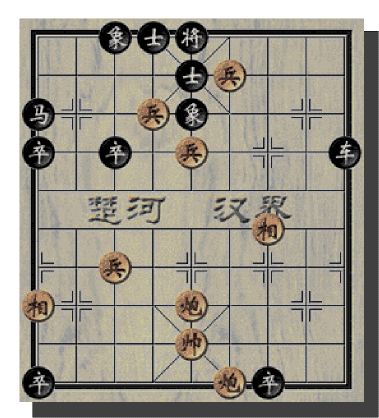|

“The pieces are moved on the intersections of lines rather than on cells”
Chess migrated from
India to China in the 8th century, but there is some
residual supporting evidence to conclude that it was
imported from India in the 2nd century AD. The pieces,
board and moves of the pieces are somewhat different
from those used by Chinese Chess players of modern
times. In the 9th century the Prime Minister of the Tang
dynasty added two new pieces called Cannon to the game.
The earliest publication on this game dates from the Ming dynasty
(1368-1644) and this book contains a collection of 70
endgames and their solutions (published in 1522).
Another book in 10 volumes and regarded as the second
oldest in the literature was published in 1570 and
contained 550 endgame examples with solutions provided.

In 1632 The Secret
Inside the Orange was published by Jin-zhen Zhu. This
book gives us a list of many complete games and 133
endgames. The Plum-Blossom Meter is a hand written
manuscript by Zai-yue Wang which was printed in 1917 for
the first time. The Chesmayne version of this game is
played on a board of 10 x 9 cells. Each side has sixteen
pieces.
In this format it is more understandable and easily playable for western
players. It is known as Elephant Chess in China. The
Chinese use a grid of 9 x 10 lines for their board and
place the pieces on the intersections of these lines,
not inside the cells as in western Chess. The
Chinese-Notation numbers the lines 1 to 9 right-to-left
for player A and 1 to 9 right-to-left for player B and
use the letters f for forward, b for back and h for
horizontal.
Therefore, C4b6 means that the Cannon on line 4 moves back six spaces,
i.e., the notation indicates the name of the piece, the
line on which the piece is located, and the direction in
which the piece moves (f, b, h). A further complication
of Chinese Chess is that each player have a notation for
their side of the board. Chinese Chess is known as
Hsiang-chi in China.
It should be noted that the names of corresponding pieces of the
opponents armies are in some cases different. The
dividing area in the middle of the board is known as the
Yellow River. The pieces are moved on the intersections
of lines rather than on cells - this pattern being
familiar to the Chinese from the game of Go, which was
well known before Chess arrived from India.
|